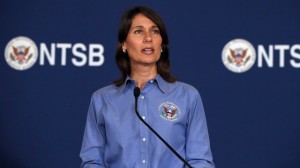
The flying pilot of Asiana Airlines Flight 214 told National Transportation Safety Board (NTSB) officials that he was "blinded" temporarily by a flash of light at 500 feet, or 34 seconds before impact -- about the same time the pilots realized they were flying too low and going too slow. The NTSB doesn't know what caused the flash, and is continuing to investigate.
At Wednesday's NTSB briefing, NTSB Chairwoman Deborah Hersman released information from the board's investigation. She detailed who was on the crew, the communications between air traffic control and the Asiana pilots, and the plane's evacuation.
Evacuation delayed 90 seconds
Additionally, crash pilots initially told flight attendants not to evacuate. A flight attendant seated in the middle of the plane looked over and saw fire outside the plane window and sent his colleague to the front of the plane to communicate with the head flight attendant. With the knowledge of the fire, the flight attendants then began to evacuate the plane, staring about a minute and a half after the crash.
NTSB officials are also saying that three flight attendants, not two, were ejected from the back of the aircraft when it hit the ground.